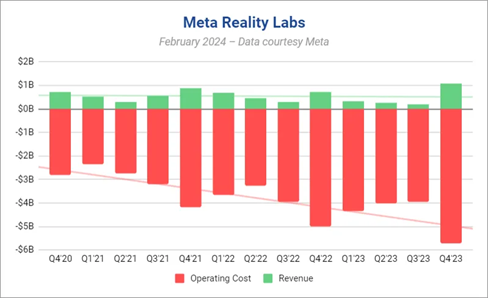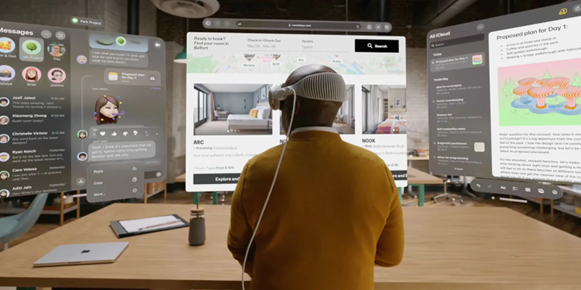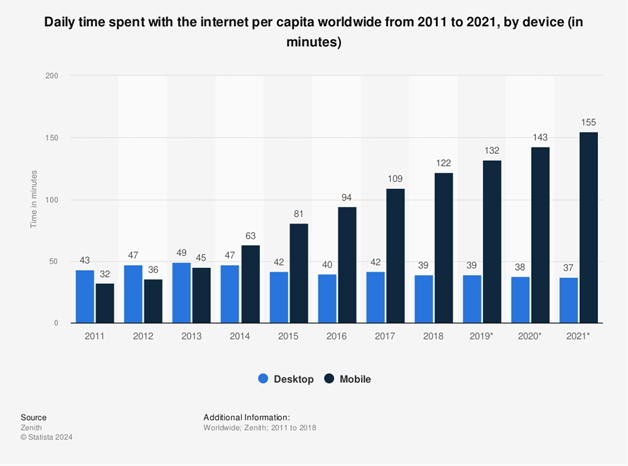
By JAMES CHENEVIX-TRENCH
Virtual, Extended and Augmented Realities and the Metaverse – building the next generation of the internet
‘The release of Apple’s vision pro represents an important moment in the history of virtual reality capable devices. It has also refocused minds on the drive toward a more immersive internet, on the lines of that promised by Facebook when they rebranded to Meta in late 2021. In this piece we examine these developments as part of a wider trend; the rapid emergence of a next generation internet that will put more powerful tools in our hands that have ever existed. We show how massive spending by big tech on virtual and augmented reality technologies is part of the same rapid technological progress that has brought breakthroughs in artificial intelligence that have already changed the digital landscape. In doing so we conclude that Big Tech is pouring money in to creating a more powerful and immersive digital future that is likely to suit their aspirations in regards to their profit margins with significant consequences for consumers, workers and wider society.’
In July 2021, a few months before the radical rebrand of Facebook, Mark Zuckerberg, told The Verge “We’re basically mediating our lives and our communication through these small, glowing rectangles. I think that that’s not really how people are made to interact…. People aren’t meant to navigate things in terms of a grid of apps. I think we interact much more naturally when we think about being present there.”[1]
At that moment, Zuckerberg was planting a stake in the ground, outlining a vision for a dramatically more immersive digital environment which has thus far defied classification. At the time he spoke these words, no viable piece of hardware existed that would allow consumers to indulge in such a world, even if they wished to. The consumer response to successive generations of the Oculus Rift had been lukewarm at best. The Oculus devices were long seen as a niche gaming products lacking mass market appeal. The rebranding of Facebook to Meta in October 2021 stirred a forensic re-examination of the concept of the ‘Metaverse’ among technology watchers and journalists; What did this mean for the future of the internet? This intellectual exercise achieved little other than revealing that no one truly knew what the metaverse was, only that it must be the next big step in the technological development of the internet.
For many the rebrand was seen as a farce (remember “Feta?” which memed on Greek cheese?), costs ballooned with little sign of any tangible gain, but Meta doggedly stuck to the general vision of a more immersive internet, even if hard definitions continue to elude everyone, including them. While they have cut costs elsewhere, most notably by laying off staff[2], their focus never wavered. During its 2023 Q4 earnings call, Meta revealed its XR (Extended Reality): a catch-all term used by Meta to refer to its augmented reality (AR), virtual reality (VR), and mixed reality (MR) division had crossed over $1bn in revenue for the first time driven by sales of the meta Quest device and games that run on it. They had also incurred the largest quarterly costs on record of US$5.72bn, resulting in a quarterly loss of US $4.65bn.

Source: Meta
The chart above shows the quarterly revenues against losses for Reality Labs (Meta’s division responsible for the metaverse). As we can see costs in this area have only grown. To spin it another way, these losses reflect belief in the mission despite definitional challenges. For Meta ‘Augmented Reality’ and ‘Artificial Intelligence’ are two sides of the same coin, and spending in both areas remains relentless.
How does Meta justify these massive costs against growing, but still comparatively small revenues? The answer lies in their belief in the value of an immersive digital future that they want to dominate. A recent report by Grand View Research[3] estimated the globalmetaverse market at US$65.5 billion in 2022 and expected a compound annual growth rate of 41.6% from 2023 to 2030.
Matthew Ball, a Silicon Valley venture capitalist who widely popularised the term ‘metaverse’, sees a consensus forming among Big Tech companies. In his words:
“We are on the cusp of a new era in which the internet isn’t something we reach for, or that runs underground and is transmitted through the air. Instead, it will be all around us and we will be in it. That the world will represented by an infinite number of 3D simulations that are running in the buildings we walk through and the cars that drive by, which dynamically manage the traffic lights of our street and manage our checkouts as we leave a store, and which involves many objects that are not “real” in the sense they cannot be touched, yet nevertheless interacted with by millions each day.”[4]
As we step timidly towards the mass market for the immersive internet, it is worth contemplating just how achievable or indeed desirable such a world really is.
The launch of Vision Pro – The potential of ‘Spatial computing’

Vision Pro was released to the public in January 2024. It is the most significant release of an Apple product in a decade. As far back as 2016, just as development of the Vision Pro was gathering pace, Apple CEO Tim Cook remarked:
“a significant portion of the population . . . will have AR experiences every day, almost like eating three meals a day. It will become that much a part of you. . . . VR I think is not going to be that big, compared to AR. I’m not saying it’s not important, it is important.”
For those who are interested in the Vision Pro It is worth spending time watching this video review from tech expert Marques Brownlee:
Pass through – A mixture of reality and simulation
Apple chooses to stay away from the negativity surrounding the virtual reality label, instead describing Vision Pro as ‘Spatial computing’. Vision Pro can be seen as a first-generation product, its current form is still likely too cumbersome and expensive for mass market appeal, however it does have promise. It introduces important new features:
A key leap forwards with the Vision Pro device is their ‘Passthrough’ technology. With pass through both in Meta Quest and Vision Pro we can see that big tech has moved away from the pure VR simulation dreams of the 90’s and towards a hybrid augmented reality which makes no distinction between physical and digital realness.
Passthrough provides real-time video from the device’s external cameras, allowing consumers to feel connected to their environment. It is so good that users forget that they are not truly ‘seeing’ the world but are instead viewing it on a screen.
Passthrough mode in Vision Pro attains its full potential when it mixes with AR. It resolves the key problem of latency – things appear to happen in real time with no lag, thereby reducing the motion sickness problems that plagued earlier VR iterations.
Virtual objects can be juxtaposed with the normal world – it could be as simple as a giant movie screen, a desktop interface, education, or professional applications. It is easy to reimagine an office without huge banks of LCD monitors. In fact, with devices like these there will be little need for offices to exist in their current form. Evidently, work could be done in a more decentralised way, it would be possible to interact with colleagues within a three-dimensional environment that would be entirely simulated. Simulations, design of three-dimensional models and navigation applications are three obvious areas where this technology is breaking new ground. It is the hope of Apple that a capable device like Vision Pro will inspire the development of a new generation of applications built to exploit the power of this new VR/AR capability. While some may not connect with Vision Pro today, the development of increasingly powerful chips will likely see these devices becoming smaller and more manageable, and more widely adopted.
The insatiable desire for digital immersion
Two core assumptions lie behind the viability of the metaverse and immersive ‘spatial computing’. First, and most obviously, we are spending ever more time in the day online.

Chart Source: Statista
The latest statistics have determined the average consumer spends 6hrs 37mins online. Smartphones have spurred usage, and now count for 3hrs 46mins of the total. American teenagers spend 7hrs 22mins per day in front of screens. That equates to 43% of their waking hours[5] and an increase of 2 hours since 2015.
The second assumption borrows from the famous line of Henry Ford “If I had asked people what they wanted, they would have said a faster horse”. Apple changed the world by giving us the smart phone at a time when there was little mobile internet speed to justify it. Established players like Nokia had what most analysts thought to be a tight grip on the market.
If it was the iPhone that redoubled time spent online, the bet for Apple here is that the Vision Pro will catalyse another profound behavioral shift into an internet world. To refer back to Henry Ford’s assertion, Apple believes that if this product can prove itself to be manifestly useful then consumers will willingly follow their lead into an immersive internet world.
The final vision for both Apple and Meta is a world in which offline and online becomes almost indistinguishable. This chimes with the opening remarks in this piece made by Zuckerberg about interacting with the digital in three-dimensional spaces rather than flat smartphones. The future internet will be physically all around us. Today’s devices evidently come up short, but few would deny their potential, even as we await a truly killer app for AR capable devices.
A social good? Spatial computing has the potential to change our perception of reality.
Alongside the advent of the smartphone era, perhaps following just in its wake, consumers’ social media engagement has proliferated. Such applications have become so ubiquitous that it is almost impossible to re-imagine the world without it. Might a similar thing be possible with devices like Vision Pro?
For anyone born this century, it is blindingly obvious the importance attached to a social media profile, and the need to project status, experiences and to be always connected. How might an increased level of immersion exacerbate these trends?
In a recent study of spatial computing at Stanford University in California researchers expressed the fear that the technology would lead to a loss of a common reality. As one researcher told Business Insider. “People will be in the same physical place, experiencing simultaneous, visually different versions of the world. We’re going to lose common ground.” Spatial computing allows users to further alter their perception of what is ‘real’ for them, extending and deepening the process already started by the internet and smartphones. This will be fodder for authoritarian regimes seeking to reinforce division in western democracies. In a world where AI is capable of constructing entire narratives and video from simple text prompts[6] and parts of our physical environment are digitally augmented, who will be able to agree on what is real? The idea of this technology being merged with immersive reality altering technology should concern everyone who values living in a free society.
Similarly deeper immersion in a digital reality should concern those already seeing the negative consequences of social media in society, but it is likely that as with previous changes regulators will struggle to keep up.
Big Tech needs us to buy in
Recent developments in spatial computing are a strong signal that we are on the cusp of a more immersive digital future that will place unprecedentedly powerful tools in our hands, as well as profit levers in the hands of already dominant tech platforms.
The rise of AI is part of this story and has already shown us how value will accrue in the next generation immersive internet. Large tech companies that have access to vast amounts of data, cash and expertise to train AI models have seen extraordinary reratings in their share prices. The need for scale to drive this technology forward gives incumbents a clear advantage over newcomers and smaller players. Those same companies are making breakthroughs in Spatial Computing because only they have the resource levels needed to deliver the technology. What is clear is that big tech needs this to work. The history of the internet has seen the birth of these massive companies capturing vast amounts of value. They have done this by evolving from startups to near monopolistic positions. We have now entered a period where technological progress has shifted up a gear and for the first time is threatening the foundations of these monopolies. Big tech has already grown to massive size is now looking to vast future markets driven by AI tools and new hardware to expand corporate profits and secure their position in the years to come. The future they want the world to follow is unsurprisingly the one where they maintain a dominant position.
A diverse range of winners
We recognise the clear advantages held by larger companies, to the extent they will dictate the consumer experience in these new immersive worlds. Governments should fear CEO’s wielding such power. Regulators must surely scramble to catch up. If all new applications are passed through the gatekeepers of Apple and Meta, they can impose enormous levies on companies wishing to operate within these environments. It is self-evident that the demand for compute must rise accordingly. The likes of ASML and TSMC are surely the obvious shovel-makers in this gold rush. This was clearly reflected in TSMC’s latest results where revenues marked an all-time high, supported by demand from Nvidia and AMD. For them, it will not matter who wins the chip design war.
Likewise, Microsoft has a firm grip on our enterprise environment looks untouchable as of today, but they will surely not sleep easily if the interface for our work existence shifts towards Spatial Computing, with hardware controlled by its two key competitors. They will surely enter the race. The development of next generation AR/VR products like Vision Pro and Meta Quest should not be seen as isolated examples or niche technologies. Instead, they must be viewed as part of a wider story that has seen our world utterly transformed by Big Tech. These emerging technologies are part of a wave of technological progress that is set to create a more powerful and more immersive digital future.
[1] https://www.theverge.com/22588022/mark-zuckerberg-facebook-ceo-metaverse-interview
[2] https://www.theguardian.com/technology/2023/apr/19/meta-layoffs-facebook-cuts-workers
[3] https://www.grandviewresearch.com/industry-analysis/metaverse-market-report
[4] https://www.matthewball.co/all/metaversespatialandmore
[5] https://www.independent.co.uk/advisor/vpn/screen-time-statistics
[6] https://www.nytimes.com/2024/02/15/technology/openai-sora-videos.html


